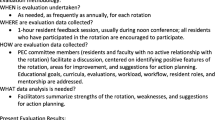Summary
Introduction/aim
Standard curricula to teach Internal Medicine residents about quality assessment and improvement, important components of the Accreditation Council for Graduate Medical Education core competencies practiced-based learning and improvement (PBLI) and systems-based practice (SBP), have not been easily accessible.
Program description
Using the American Board of Internal Medicine’s (ABIM) Clinical Preventative Services Practice Improvement Module (CPS PIM), we have incorporated a longitudinal quality assessment and improvement curriculum (QAIC) into the 2 required 1-month ambulatory rotations during the postgraduate year 2. During the first block, residents complete the PIM chart reviews, patient, and system surveys. The second block includes resident reflection using PIM data and the group performing a small test of change using the Plan–Do–Study–Act (PDSA) cycle in the resident continuity clinic.
Program Evaluation
To date, 3 resident quality improvement (QI) projects have been undertaken as a result of QAIC, each making significant improvements in the residents’ continuity clinic. Resident confidence levels in QI skills (e.g., writing an aim statement [71% to 96%, P < .01] and using a PDSA cycle [9% to 89%, P < .001]) improved significantly.
Discussion
The ABIM CPS PIM can be used by Internal Medicine residency programs to introduce QI concepts into their residents’ outpatient practice through encouraging practice-based learning and improvement and systems-based practice.
Similar content being viewed by others
References
Holmboe ES, et al. Teaching and improving quality of care in a primary care internal medicine Residency Clinic. Acad Med. 2005;80(6):571–7.
Ogrinc G, et al. Teaching and assessing resident competence in practice-based learning and improvement. J Gen Intern Med. 2004;19:496–500.
Canal DF, et al. Practice-based learning and improvement: a curriculum in continuous quality improvement for surgery residents. Arch of Surg. 2007;142(5):479–82.
Djuricich A, et al. A continuous quality improvement curriculum for residents: addressing core competency, improving systems. Acad Med. 2004;79(S10):S65–7.
Ziegelstein RC, et al. The mirror and the village; a new method for teaching practiced-based learning and improvement and systems-based practice. Acad Med. 2004;79:83–8.
Krajewski K, et al. A quality assurance elective for radiology residents. Acad Radiol. 2007;14:239–45.
Weingart SN, et al. Creating a quality improvement elective for medical house officers. J Gen Intern Med. 2004;19:861–7.
Zenni EA, et al. A walk in the patients’ shoes: a step toward competency development system based practice. Ambul Pediatr. 2006;6(1):54–7.
Boonyasi RT, et al. Effectiveness of teaching quality improvement to clinicians. JAMA. 2007;298(9):1023–38.
Institute of Medicine. Crossing the Quality Chasm. Washington, DC: National Academy; 2001.
Mcglynn EA, et al. The quality of healthcare delivered to adults in the United States. N Engl J Med. 2003;348:2635–45.
Brennan TA, et al. The Role of Physician Specialty Board Certification Status in the Quality Movement. JAMA. 2004;292:1038–43.
Holmboe ES, et al. Promoting physican’ self assessment and quality improvement: The ABIM diabete practice improvement module. J Contin Educ Health Prof. 2006;26:109–19.
American Board of Internal Medicine Macy (CoVE) Project. Available at http://www.abimfoundation.org/quality/cove.shtm Accessed January 1, 2008.
American Board of Internal Medicine Practice Improvement Modules. Available at https://www.abim.org/residency/residency.aspx Accessed January 1, 2008.
American Board of Internal Medicine Clinical Preventative Services Practice Improvement Modules. Available at http://www.abim.org/online/pim/demo.aspx Accessed January 1, 2008.
Acknowledgments
This study was supported by internal funding from University of Chicago, Graduate Medical Education Committee, and Department of Medicine. We are grateful to Dr. Jim Woodruff, Dr. Eric Holmboe, Dr. Greg Orgrinc, and Ms. Kim Alvarez for their support in pursuing this research. Prior presentations of this data include a plenary session presentation at the National Society of General Internal Medicine Annual Meeting in Toronto, Canada, in April 2007, an oral presentation at the Midwest Society of General Internal Medicine Annual Meeting in Chicago, IL, in September 2007, and an oral presentation at the IHI conference in Orlando, FL, in December 2007.
Conflict of Interest
None disclosed.
Author information
Authors and Affiliations
Corresponding author
Rights and permissions
About this article
Cite this article
Oyler, J., Vinci, L., Arora, V. et al. Teaching Internal Medicine Residents Quality Improvement Techniques using the ABIM’s Practice Improvement Modules. J GEN INTERN MED 23, 927–930 (2008). https://doi.org/10.1007/s11606-008-0549-5
Published:
Issue Date:
DOI: https://doi.org/10.1007/s11606-008-0549-5




